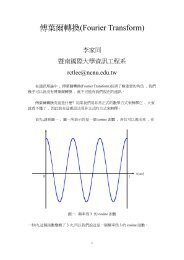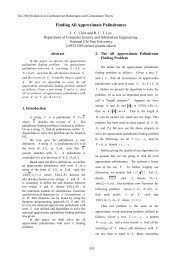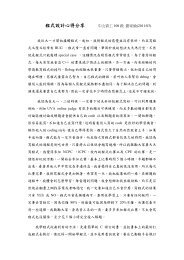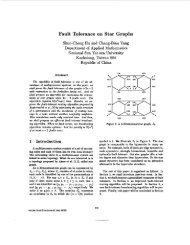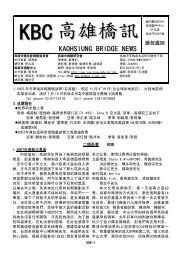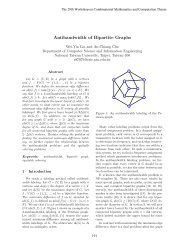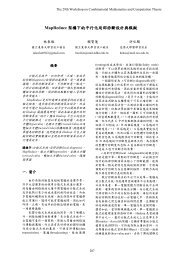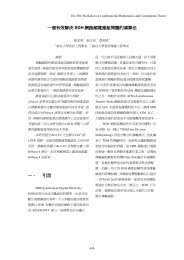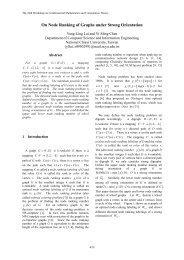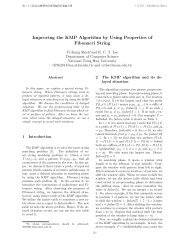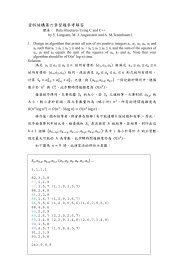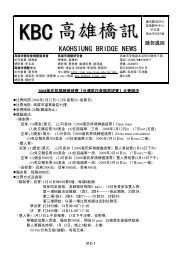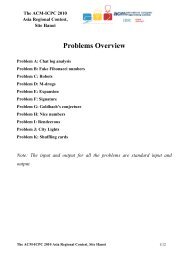Involution Palindrome DNA Languages
Involution Palindrome DNA Languages
Involution Palindrome DNA Languages
Create successful ePaper yourself
Turn your PDF publications into a flip-book with our unique Google optimized e-Paper software.
In the following propositions, some properties<br />
of the skew θ-palindrome words are studied when<br />
θ is an antimorphic involution.<br />
Proposition 3.6 Let θ be an antimorphic involution<br />
on X ∗ . A word w is skew θ-palindrome if and<br />
only if w is a product of two θ-palindrome words.<br />
Proof. Let θ be an antimorphic involution on<br />
X ∗ . If w is skew θ-palindrome, then there exist<br />
u, v ∈ X ∗ such that w = uv, θ(w) = vu. Since<br />
θ is an antimorphic involution, θ(w) = θ(uv) =<br />
θ(v)θ(u). We have θ(v)θ(u) = vu. Hence θ(v) = v<br />
and θ(u) = u. Then w is a product of two θ-<br />
palindrome words. Conversely, suppose that w =<br />
uv where u = θ(u), v = θ(v) for some u, v ∈ X ∗ .<br />
Then θ(w) = θ(uv) = θ(v)θ(u) = vu; hence w is a<br />
skew θ-palindrome word.<br />
Proposition 3.6 is not true where θ is a morphic<br />
involution. For example, let X = {a, b} and θ be<br />
a morphic involution that maps a to b and vice<br />
versa. As w = ab, θ(w) = θ(ab) = θ(a)θ(b) = ba.<br />
Then w is skew θ-palindrome. However, a, b are<br />
not θ-palindromes. Note that every θ-palindrome<br />
word is a skew θ-palindrome word because any<br />
palindrome word as a product of itself and the<br />
empty word λ.<br />
Lemma 3.7([7]) Let θ be an antimorphic involution.<br />
Then for u, v ∈ X + , u, v ∈ R θ if and only if<br />
(uv) k u ∈ R θ for some k ≥ 0.<br />
Proposition 3.7 Let θ be an antimorphic involution.<br />
If w is skew θ-palindrome, then for n ≥ 2,<br />
w n has at least two different decompositions as<br />
product of two θ-palindromes.<br />
Proof. Let θ be an antimorphic involution and<br />
w be a skew θ-palindrome word. By Proposition<br />
3.6, there exist w 1 , w 2 ∈ R θ such that w = w 1 w 2 .<br />
Then<br />
w n = w 1<br />
(<br />
(w2 w 1 ) n−1 w 2<br />
)<br />
= (w 1 w 2 w 1 ) ( (w 2 w 1 ) n−2 w 2<br />
)<br />
.<br />
Moreover, by Lemma 3.7, we have that<br />
(w 1 w 2 ) i w 1 and (w 2 w 1 ) j w 2 for i, j ≥ 0 are θ-<br />
palindromes. This complete the proof.<br />
Proposition 3.8 Let θ be an antimorphic involution.<br />
A word w is skew θ-palindrome if and only<br />
if w n is skew θ-palindrome for n ≥ 2.<br />
Proof. Let θ be an antimorphic involution. If w<br />
is skew θ-palindrome, by Propositions 3.6 and 3.7,<br />
then w n is skew θ-palindrome for n ≥ 2. Conversely,<br />
let w n be a skew θ-palindrome word for<br />
n ≥ 2. There exist w 1 , w 2 ∈ X + with w = w 1 w 2<br />
such that w n = (w i w 1 )(w 2 w j ) where i + j = n − 1<br />
for some i, j ≥ 0. By the definition of skew θ-<br />
palindrome word, we have θ(w n ) = (w 2 w j )(w i w 1 ).<br />
Since θ is an antimorphic involution,<br />
θ(w n ) = θ ( (w i w 1 )(w 2 w j ) )<br />
= θ(w 2 w j )θ(w i w 1 )<br />
= ( θ(w) ) j<br />
θ(w2 )θ(w 1 ) ( θ(w) ) i<br />
= ( θ(w 2 )θ(w 1 ) ) j<br />
θ(w2 ) ( θ(w 1 )θ(w 2 ) ) i<br />
θ(w1 )<br />
= (w 2 w j )(w i w 1 ).<br />
This implies that θ(w 1 ) = w 1 and θ(w 2 ) = w 2 .<br />
By Proposition 3.6, w is skew θ-palindrome.<br />
Given an involution θ, for any skew θ-<br />
palindrome word u, there exists a unique pair<br />
(x, y) such that u = pq and p = (xy) i−k−1 x, q =<br />
y(xy) k . We call (x, y) the twin-roots of u with respect<br />
to θ, or shortly θ-twin-roots of u.([12])<br />
4 The Non-<strong>Involution</strong> <strong>Palindrome</strong><br />
Words<br />
In this section, we study the words which are<br />
not θ-palindrome for an antimorphic involution θ.<br />
To characterize the properties of non-involution<br />
palindrome words, we consider the θ-commutative<br />
relation which was defined in [6]. Let θ be either a<br />
morphic or an antimorphic involution. We recall<br />
that the θ-commutative relation in [6] is as follow:<br />
the θ-commutative relation ≤ θ c on X ∗ is defined<br />
by<br />
v ≤ θ c u ⇔ u = vx = θ(x)v for some x ∈ X ∗ ,<br />
where u, v ∈ X ∗ .<br />
For u ∈ X ∗ , let L θ c(u) = {v ∈ X ∗ |v ≤ θ c u}<br />
and N(u) = |L θ c(u)|. For i ≥ 1, let C θ (i) = {u ∈<br />
X + |N(u) = i}. For example, let X = {a, b} and<br />
θ be an antimorphic involution that maps a to b<br />
and vice versa. Let u = ab. We have<br />
• u = ab · 1 = θ(1) · ab,<br />
• u = a · b ≠ θ(b) · a = aa,<br />
• u = 1 · ab = θ(ab) · 1 = θ(b)θ(a) = ab.<br />
Then 1, ab ∈ L θ c(ab); hence ab ∈ C θ (2). Note<br />
that the word ab is θ-palindrome for an antimorphic<br />
involution θ. However, the word ab ∈ C θ (1)



